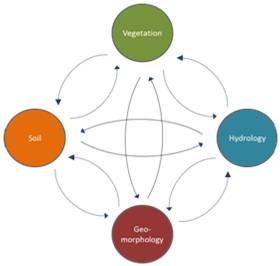
HILLSlope Chronosequence And Process Evolution
Human activities and climate change are rapidly changing the Earth's surface. However, our understanding of how soils change over time and how this influences ecological, hydrological and geomorphological processes is still elementary. Some soil properties are persistent, but others can change rapidly with significant effects on water quantity and quality. This is particularly true at the hillslope scale, where lateral and vertical transport processes interact over various timescales. Water and vegetation shape the surface and subsurface properties of hillslopes through weathering, soil development, and erosion. These processes, in turn, control water flow paths. The distribution of water also affects the vegetation, while vegetation in turn also affects the flow pathways for water. Although all of these processes affect each other, their numerous interactions have only recently become a research focus. The multidisciplinary HILLSlope Chronosequence And Process Evolution (HILLSCAPE) project focuses on the vertical and lateral redistribution of water and matter along hillslopes and how this redistribution affects and is affected by soil, vegetation and landscape development.
Research question
The overall research question of the project is: How does the hillslope feedback cycle evolve in the first 10,000 years and how is this related to the evolution of hillslope structure, including plant cover?
Approach
HILLSCAPE will identify the dominant controls on hillslope functioning and their feedback processes at hillslopes on moraines of different ages and thus stages in their evolution. We use a chronosequence of highly instrumented plots at two different locations with different parent material (Sustenpass in 2018 and Klausenpass in 2019) and follow an all-measurements-on-all-plots approach to ensure integration of the different datasets and insights. We determine the hillslope structure and vegetation complexity at each of these plots and study the hydrological and geomorphological processes during frequent and extreme rainfall events by conducting a series of artificial rainfall experiments. We will also quantify the relevant structural and functional traits and characteristics of the co-occurring plants to derive indices of structural and functional diversity. The combination of four interdisciplinary PhD projects and integrative modelling work allows us to understand how hillslope structure and functioning and their feedback processes change during hillslope evolution.
The Hillscape team
Publications
Hartmann, A., E. Semenova, M. Weiler, and T. Blume (2020), Field observations of soil hydrological flow path evolution over 10 millennia, Hydrol. Earth Syst. Sci., 24(6), 3271-3288 .
Maier, F., I. van Meerveld, K. Greinwald, T. Gebauer, F. Lustenberger, A. Hartmann, and A. Musso (2020), Effects of soil and vegetation development on surface hydrological properties of moraines in the Swiss Alps, CATENA, 187, 104353.
Musso, A., M. E. Ketterer, K. Greinwald, C. Geitner, and M. Egli Rapid decrease of soil erosion rates with soil formation and vegetation development in periglacial areas, Earth Surface Processes and Landforms, https://doi.org/10.1002/esp.4932.
Musso, A., K. Lamorski, C. Sławiński, C. Geitner, A. Hunt, K. Greinwald, and M. Egli (2019), Evolution of soil pores and their characteristics in a siliceous and calcareous proglacial area, CATENA, 182, 104154.
Funding
The HILLSCAPE project is funded by the DFG and the SNF


